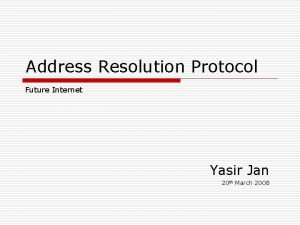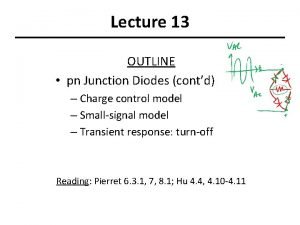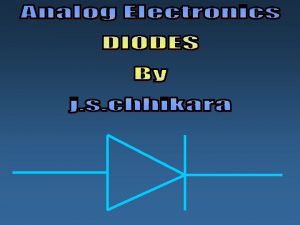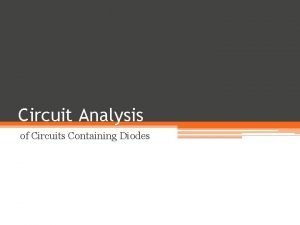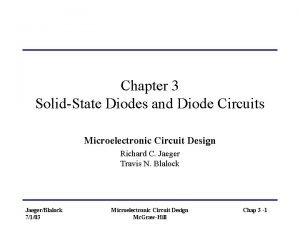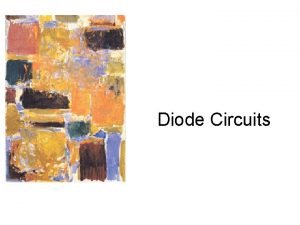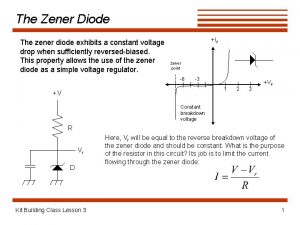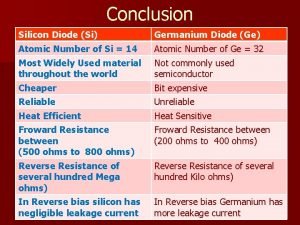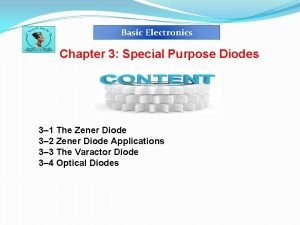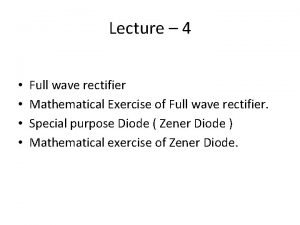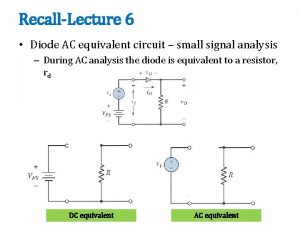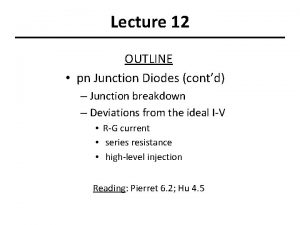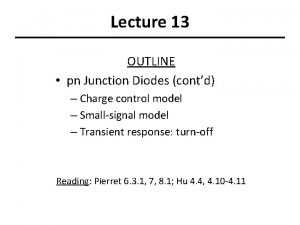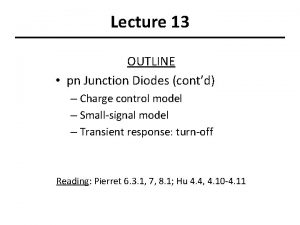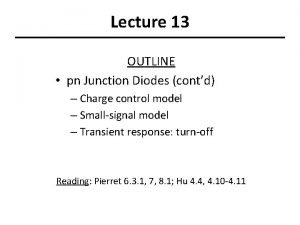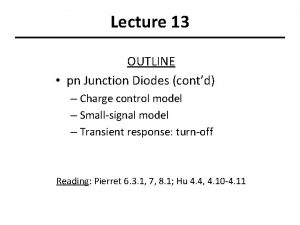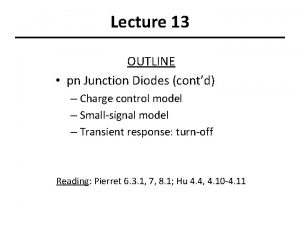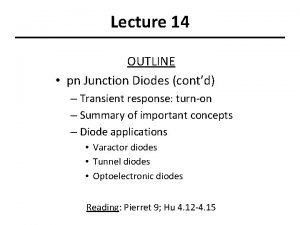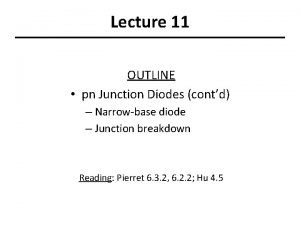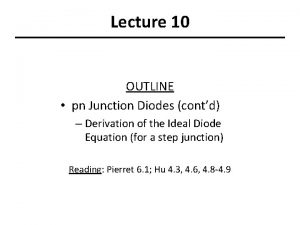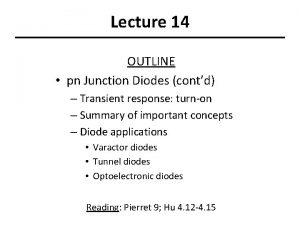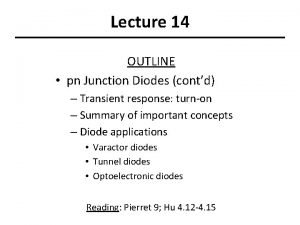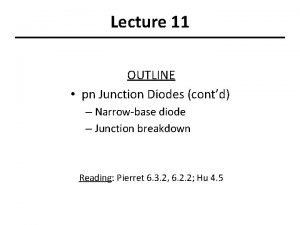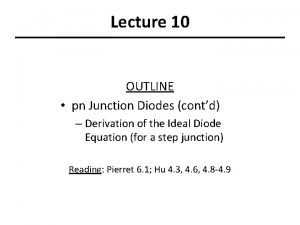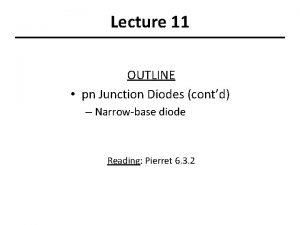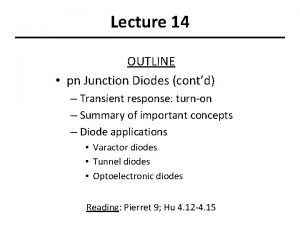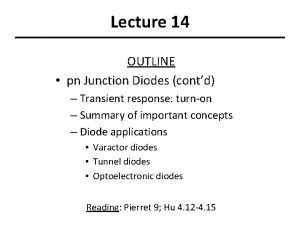Lecture 13 OUTLINE pn Junction Diodes contd Charge





















- Slides: 21

Lecture 13 OUTLINE • pn Junction Diodes (cont’d) – Charge control model – Small-signal model – Transient response: turn-off Reading: Pierret 6. 3. 1, 7, 8. 1; Hu 4. 4, 4. 10 -4. 11

Minority-Carrier Charge Storage • Under forward bias (VA > 0), excess minority carriers are stored in the quasi-neutral regions of a pn junction: EE 130/230 A Fall 2013 Lecture 13, Slide 2

Derivation of Charge Control Model Consider the n quasi-neutral region of a forward-biased pn junction: • The minority carrier diffusion equation is (assuming GL=0): • Since the electric field is very small, • Therefore EE 130/230 A Fall 2013 Lecture 13, Slide 3

Derivation Assuming a Long Base • Integrating over the n quasi-neutral region: • Note that • So EE 130/230 A Fall 2013 Lecture 13, Slide 4

Charge Control Model We can calculate pn-junction current in 2 ways: 1. From slopes of np(-xp) and pn(xn) 2. From steady-state charges QN, QP stored in each excessminority-charge distribution: EE 130/230 A Fall 2013 Lecture 13, Slide 5

Charge Control Model for Narrow Base • For a narrow-base diode, replace tp and/or tn by the minority-carrier transit time ttr – time required for minority carrier to travel across the quasineutral region – For holes in narrow n-side: – Similarly, for electrons in narrow p-side: EE 130/230 A Fall 2013 Lecture 13, Slide 6

Charge Control Model Summary • Under forward bias, minority-carrier charge is stored in the quasi-neutral regions of a pn diode. – Long base: – Narrow base: EE 130/230 A Fall 2013 Lecture 13, Slide 7

• The steady-state diode current can be viewed as the charge supply required to compensate for charge loss via recombination (for long base) or collection at the contacts (for narrow base). – Long base (both sides): – Narrow base (both sides): where and Note that EE 130/230 A Fall 2013 Lecture 13, Slide 8

Small-Signal Model of the Diode i + v Small-signal conductance: EE 130/230 A Fall 2013 Lecture 13, Slide 9

Charge Storage in pn Junction Diode • Excess minority carriers in the quasi-neutral region: Dpn(x) Dnp(x) -xp xn x • Majority carriers stored at the edges of the depletion regions: -xp r(x) xn EE 130/230 A Fall 2013 Lecture 13, Slide 10 x

pn Junction Small-Signal Capacitance 2 types of capacitance associated with a pn junction: depletion capacitance - due to variation of depletion charge diffusion capacitance –due to variation of stored minority charge in the quasi-neutral regions For a one-sided p+n junction Q = QP + QN QP so EE 130/230 A Fall 2013 Lecture 13, Slide 11

Depletion Capacitance C. C. Hu, Modern Semiconductor Devices for ICs, Figure 4 -8 What are three ways to reduce CJ? EE 130/230 A Fall 2013 Lecture 13, Slide 12

Total pn-Junction Capacitance C = C D + CJ • CD dominates at moderate to high forward biases • CJ dominates at low forward biases, reverse biases EE 130/230 A Fall 2013 Lecture 13, Slide 13

Using C-V Data to Determine Doping EE 130/230 A Fall 2013 Lecture 13, Slide 14

Example If the slope of the (1/C)2 vs. VA characteristic is -2 x 1023 F-2 V-1, the intercept is 0. 84 V, and A is 1 mm 2, find the dopant concentration Nl on the more lightly doped side and the dopant concentration Nh on the more heavily doped side. Solution: EE 130/230 A Fall 2013 Lecture 13, Slide 15

Small-Signal Model Summary Depletion capacitance Conductance Diffusion capacitance EE 130/230 A Fall 2013 Lecture 13, Slide 16 R. F. Pierret, Semiconductor Device Fundamentals, p. 302

Transient Response of pn Diode • Suppose a pn-diode is forward biased, then suddenly turned off at time t = 0. Because of CD, the voltage across the pn junction depletion region cannot be changed instantaneously. The time delay in switching between the FORWARD-bias and REVERSE-bias states is due to the time required to change the amount of excess minority carriers stored in the quasi-neutral regions. EE 130/230 A Fall 2013 Lecture 13, Slide 17 R. F. Pierret, Semiconductor Device Fundamentals, Fig. 8. 2

Turn-Off Transient • In order to turn the diode off, the excess minority carriers must be removed by net carrier flow out of the quasi-neutral regions and/or recombination – Carrier flow is limited by the switching circuitry EE 130/230 A Fall 2013 Lecture 13, Slide 18 R. F. Pierret, Semiconductor Device Fundamentals, p. 328

Decay of Stored Charge Consider a p+n diode (Qp >> Qn): pn(x) i(t) ts t v. A(t) R. F. Pierret, Semiconductor Device Fundamentals, Fig. 8. 3 ts For t > 0: EE 130/230 A Fall 2013 Lecture 13, Slide 19 t

Storage Delay Time, ts • ts is the primary “figure of merit” used to characterize the transient response of pn junction diodes • By separation of variables and integration from t = 0+ to t = ts, noting that and making the approximation We conclude that EE 130/230 A Fall 2013 Lecture 13, Slide 20

Qualitative Examples Illustrate how the turn-off transient response would change: Increase IF Decrease tp Increase IR i(t) ts EE 130/230 A Fall 2013 t i(t) ts Lecture 13, Slide 21 t ts t
 Address contd
Address contd What is your function
What is your function Quasi saturation in power bjt
Quasi saturation in power bjt Solved: problem 4: pn junction diode charge control model
Solved: problem 4: pn junction diode charge control model 01:640:244 lecture notes - lecture 15: plat, idah, farad
01:640:244 lecture notes - lecture 15: plat, idah, farad Lecture outline example
Lecture outline example Lecture outline example
Lecture outline example Lecture outline meaning
Lecture outline meaning Lecture outline example
Lecture outline example Electrons flowing
Electrons flowing Difference between charge and electric charge
Difference between charge and electric charge What are diodes made of
What are diodes made of Circuit analysis with diodes
Circuit analysis with diodes Solid state diode
Solid state diode Practical diode model
Practical diode model Zener diode oscillator
Zener diode oscillator Silicon diode symbol
Silicon diode symbol Special purpose diodes
Special purpose diodes Full wave rectifier 4 diodes
Full wave rectifier 4 diodes Diodes
Diodes Simbol potensiometer
Simbol potensiometer Small signal analysis of diode
Small signal analysis of diode
